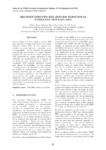Mostrar o rexistro simple do ítem
Reconocimiento del estado emocional mediante señales EEG
| dc.contributor.author | Marco, Rubén | |
| dc.contributor.author | Iáñez, Eduardo | |
| dc.contributor.author | Ortiz, Mario | |
| dc.contributor.author | Azorín, José M. | |
| dc.date.accessioned | 2020-02-05T09:30:54Z | |
| dc.date.available | 2020-02-05T09:30:54Z | |
| dc.date.issued | 2018 | |
| dc.identifier.citation | Marco, R., Iáñez, E., Ortiz, M., Azorín, J. M. Reconocimiento del estado emocional mediante señales EEG. En Actas de las XXXIX Jornadas de Automática, Badajoz, 5-7 de Septiembre de 2018 (pp.21-27). DOI capítulo: https://doi.org/10.17979/spudc.9788497497565.0021 DOI libro: https://doi.org/10.17979/spudc.9788497497565 | es_ES |
| dc.identifier.isbn | 978-84-09-04460-3 (UEX) | |
| dc.identifier.isbn | 978-84-9749-756-5 (UDC electrónico) | |
| dc.identifier.uri | http://hdl.handle.net/2183/24832 | |
| dc.description.abstract | [Resumen] En este trabajo se ha desarrollado un sistema BMI para reconocer el estado emocional de los sujetos mediante señales EEG. Se han definido tres estados emocionales diferentes: agradable, neutro y desagradable. Se ha diseñado un protocolo experimental que muestra a 5 sujetos diversas imágenes de cada uno de los estados planteados. Tras procesar las señales registradas se han obtenidos sus características en el dominio de la frecuencia para posteriormente aplicar un clasificador SVM mediante validación cruzada para obtener los resultados. Se han evaluado 5 configuraciones de electrodos y dos tamaños de ventana de procesamiento. Los resultados obtenidos muestran que las señales registradas en las regiones próximas a las temporales son representativas del estado emocional y que la distinción entre estados agradables y neutros resulta más sencilla que el resto de clasificaciones, alcanzándose un porcentaje de acierto medio del 76% al respecto. | es_ES |
| dc.description.abstract | [Abstract] In this work, a BMI system has been developed to recognize the emotional state of the users through EEG signals. Three different emotional states have been defined (pleasant, neutral and unpleasant), as well as an experimental design to register them in 5 individuals, consisting on the visualization of distinct types of images for each of these states. After the register, the signals acquired have been filtered and a their features have been extracted in the frequency domain to apply a SVM classifier through cross validation, obtaining the results. 5 configurations of electrodes and two sizes of processing windows have been evaluated. The results show that signals registered near to temporal lobes are representative of the emotional state and that the distinction between pleasant and neutral states is easier than the rest of classifications, reaching an average success rate of 76%. | es_ES |
| dc.description.sponsorship | Generalitat Valenciana; FEDER 2007/2013 | es_ES |
| dc.language.iso | spa | es_ES |
| dc.publisher | Área de Ingeniería de Sistemas y Automática, Universidad de Extremadura | es_ES |
| dc.relation.hasversion | http://hdl.handle.net/10662/8104 | |
| dc.relation.uri | https://doi.org/10.17979/spudc.9788497497565.0021 | es_ES |
| dc.rights | Atribución-NoComercial 3.0 España | es_ES |
| dc.rights.uri | http://creativecommons.org/licenses/by-nc/3.0/es/ | * |
| dc.subject | BMI | es_ES |
| dc.subject | EEG | es_ES |
| dc.subject | Estado emocional | es_ES |
| dc.subject | Emotional state | es_ES |
| dc.title | Reconocimiento del estado emocional mediante señales EEG | es_ES |
| dc.title.alternative | Emotional state recognition through EEG signals | es_ES |
| dc.type | info:eu-repo/semantics/conferenceObject | es_ES |
| dc.rights.access | info:eu-repo/semantics/openAccess | es_ES |
| UDC.startPage | 21 | es_ES |
| UDC.endPage | 27 | es_ES |
| dc.identifier.doi | https://doi.org/10.17979/spudc.9788497497565.0021 | |
| UDC.conferenceTitle | XXXIX Jornadas de Automática | es_ES |






